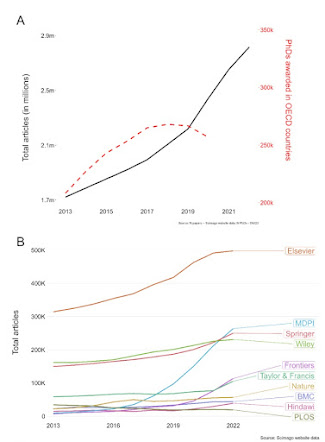Over the holiday weekend, we had a paper come out in which we report the results of measuring charge shot noise (see here also) in a strange metal. Other write-ups of the work (here and especially this nice article in Quanta here) do a good job of explaining what we saw, but I wanted to highlight a couple of specific points that I think deserve emphasis.
In thermal equilibrium at some temperature \(T\), there are current and voltage fluctuations in a conductor - this is called Johnson-Nyquist noise - and it is unavoidable. Shot noise in electrical current results from the granularity of charge and, as shown in its original incarnation (pdf is in German), from the statistical variation in the arrival times of electrons. Shot noise is an "excess" noise that appears in addition to this, only when a conductor is driven out of equilibrium by an applied voltage and carries a net current.
While the idea of shot noise is tunnel junctions and vacuum tubes had been worked out a long time ago (see the above 1918 paper by Schottky), it was in the 1990s when people really turned to the question of what one should see in noise measurements in small metal or semiconductor wires. Why don't we see shot noise in macroscopic conductors like your house wiring? Well, shot noise requires some deviation of the electrons from their thermal equilibrium response - otherwise you would just have Johnson-Nyquist noise. The electrons in a metal or semiconductor are coupled to the vibrations of the atoms (phonons) - the clearest evidence for this is that the decrease in scattering of the electrons by the phonons explains why metals become more conductive as temperature is decreased. In conductors large compared to the (temperature-dependent) electron-phonon scattering length, the electrons should basically be in good thermal equilibrium with the lattice at temperature \(T\), so all that should be detected is Johnson-Nyquist noise. To see shot noise in a wire, you'd need the wire to be small compared to that e-ph length, typically on the order of a micron at low temperatures. In the 1980s and 1990s, it was now possible to make structures on that scale.
 |
| Fig. 4 from the paper |
- Until recently there really has not been much attempt to push the theoretical analysis of these kinds of measurements beyond the 1990s/early 2000s results. My colleague Qimiao Si and his group have looked at whether strong Fermi liquid corrections affect the expected noise, and the answer is "no". Of course, there are all kinds of additional complications that one could imagine.
- This work was only possible because of the existence of high quality thin films of the material, and the ability to fabricate nanostructures from this stuff without introducing so much disorder or chemical change as to ruin the material. My collaborator Silke Bühler-Paschen and her group have spent years learning how to grow this and related materials, and long-term support for materials growth is critically important. My student, the lead author on the study, did great work figuring out the fabrication. It's really not trivial.
- I think it's worthwhile to consider pushing older techniques into new regimes and applying them to new materials systems. The heyday of mesoscopics in the 1990s doesn't need to be viewed as a closed, somewhat completed subfield, but rather as a base from which to consider new ways to characterize the rich variety of materials and phases that we have to play with in condensed matter.
